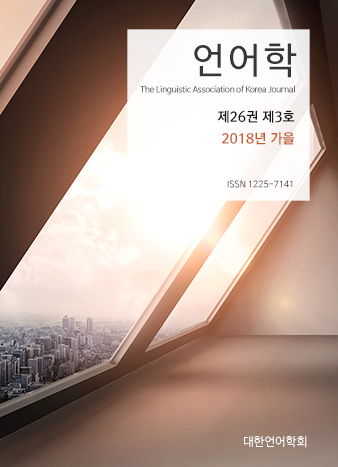대한언어학회 전자저널

26권 3호 (2018년 9월)
- 제주 한국어 음상 강화형 반복 부사어 연구
-
강석한
Pages : 89-116
Abstract
Kang, Seokhan. (2018). A study of emphatic adverbial reduplication in Jeju Korean. The Linguistic Association of Korea Journal, 26(3), 89-116. It is argued that adverbial reduplication in Jeju Korean intensifies the sound effect through the template extension and rhythmic realization. Two types of reduplication (total and alternative) have been investigated, with consideration given to the relationship between input and output as well as between output and output. To accelerate the sound effect in the total reduplication, the consonantal and feature addition, and vowel alternation have been used, resulting in emphatic forms as the output patterns. The alternative-reduplication pursues Obligatory Contour Principle (OCP) between the base and the reduplicant against OO-Identity. As a result, the OCP constraint caused the sound effect between the base and the reduplicant, using the asymmetry of f0 and duration. The final pattern of the emphatic reduplication involved adding lak(lang) to the second emphatic reduplication with the liquid coda. The study implies that the alternative forms in the adverbial reduplication of Jeju Korean pursue the melody effect, using markedness constraints.
Keywords
# 유사 중첩(alternative reduplication) # 완전 중첩(total reduplicatiion) # 제주 한국어(Jeju Korean) # 제약(constraints) # 최적성 이론(optimality theory) # 강조형 상징어(emphatic ideophones
References
- 강공택. (1986). 제주 방언의 반복 부사 구조 연구. 제주대학교 석사학위논문.
- 강석한. (2010). 제주 한국어의 반복 부사어 변이형 형성에서의 발화와 인지요소 연구. 영주어문, 20, 5-26.
- 강옥미. (1993). 운율어 내에서 일어나는 한국어 음운현상. 어문논집, 3, 11-22.
- 강옥미. (1998). 한국어의 부분중첩에 대한 대응이론 분석. 음성음운형태론연구, 4, 31-54.
- 강정희. (2005). 제주 방언 형태 변화 연구. 서울: 역락출판사.
- 고동호. (1996). 제주 방언의 유기음과 경음의 형성 과정. 한글, 234, 163-189.
- 김광웅. (2001). 제주지역어 음운론. 제주: 제주대학교 출판부.
- 김영돈. (1965). 제주도 민요연구(상). 서울: 일조각.
- 남기심, 고영근. (1993). 표준국어문법론. 서울: 탑출판사.
- 박동규. (2000). 어두 자, 모음 대립형 반복 복합어의 형성에 관한 고찰. 인문과학연구, 5, 75-95.
- 박용후. (1988). 제주방언 연구 <자료편>. 서울: 고려대학교 민족문화 연구소.
- 박종희, 권병로. (2010). 음절 무게 투영과 겹자음화. 배달말, 47, 93-114.
- 송상조. (2007). 제주말 큰 사전. 서울: 한국문화사.
- 송정근. (2010). 중첩의 두 유형. 한국어 의미학, 33, 131-152.
- 손형숙, 안미애. (2009). 한국어와 영어의 모음 발음영역에 대한 실험음성화적 연구. 언어과학연구, 49, 117-140.
- 신우봉, 신지영. (2012). 제주 방언 단모음에 대한 음향 음성학적 연구. 한국어학, 56, 63-90.
- 이경희, 정명숙. (2000). 한국어 파열음의 음향적 특성과 지각 단서. 음성과학, 7(2), 154-170.
- 이익섭. (1982). 현대국어의 반복복합어의 구조. 국어학연구(백영정병욱선생 환갑기념논총). 서울: 신구문화사
- 이희승. (1955). 국어학개설. 서울: 민중서관
- 전종호, 이혜민. (2006). 한국어 부분중첩에서의 가변적 접사. 음성음운형태론연구, 12(1), 149-159.
- 정철주. (2015). 의사 반복 합성어의 유형과 형성. 인문과학연구, 26, 69-96.
- 제주특별자치도. (2009). 제주어사전. 제주: 일신옵셋인쇄사.
- 채완. (1986). 국어어순의 연구. 서울: 탑출판사.
- 현용준. (1980). 占제주도무속자료사전전, 서울: 신구문화사.
- 현평효. (1985). 제주도 방언 연구. 서울: 이우출판사.
- Alber, B. (2005). Clash, lapse and directionality. Natural Language & Linguistic Theory, 23(3), 485-542.
- Assman, W. F., & Kartz, W. F. (2000). Time-varying spectral change in the vowels of children and adults. Journal of the Acoustical Society of America, 102, 28-40.
- Balle, M. (2017). Types of reduplication in Helong, an Austronesian language in Eastern Indonesia. Unpublished doctoral dissertation, Payap University.
- Boersma, P. (2000). The OCP in the perception grammar. University of Amsterdam. Retrieved from http://www.fon.hum.uva.nl/paul/papers/ocp_perc.pdf.
- Flemming, E. (1996). Evidence for constraints on contrast: The dispersion theory of contrast. UCLA Working Papers in Phonology, 1, 86-106.
- Flemming, E. (2005). Speech perception and phonological contrast. In D. Pisoni & R. Remez (Eds.), The handbook of speech perception (pp. 156-181). Cambridge: Blackwell.
- Itô, J. (1989). A prosodic theory of epenthesis. Natural Language & Linguistic Theory, 7(2), 217-259.
- Goldsmith, J. (1976). Autosegmental phonology. Unpublished doctoral dissertation, MIT.
- Hayes, B. (1989). Compensatory lengthening in moraic phonology. Linguistic inquiry, 20(2), 253-306.
- Kang, S-H. (2008). Non-morphological motivation in Cheju Korean emphatic reduplication. Proceedings in ICKL 2008. Cornell University.
- Kang, S.-K. (1992). A moraic study of some phonological phenomena in English and Korean. Unpublished doctoral dissertation, University of Illinois at Urbana-Champaign.
- Kim, J.-H. (1997). An optimality-theoretic approach to reduplication in Korean ideophones. Language Research, 33(4), 737-752.
- Leben, W. (1973). Suprasegmental phonology. Unpublished doctoral dissertation, MIT.
- Lee, J.-S. (1992). Phonology and sound symbolism of Korean ideophonies. Unpublished doctoral dissertation, Indiana University.
- MacCarthy, J. (1986). OCP effects: gemination and antigemination. Linguistic Inquiry, 17, 207-263.
- McCarthy, J. J., & Prince, A. (1995). Faithfulness and reduplicative identity. Linguistics Department Faculty Publication Series, 10, 1-126.
- Marantz, A. (1982). Reduplication. Linguistic Inquiry, 13, 435-482.
- Silva, D. J. (2006). Acoustic evidence for the emergence of tonal contrast in contemporary Korean. Phonology, 23, 287-308.
- Yang, B. (1996). A comparative study of American English and Korean vowels produced by male and female speakers. Journal of Phonetics, 24, 245-262.